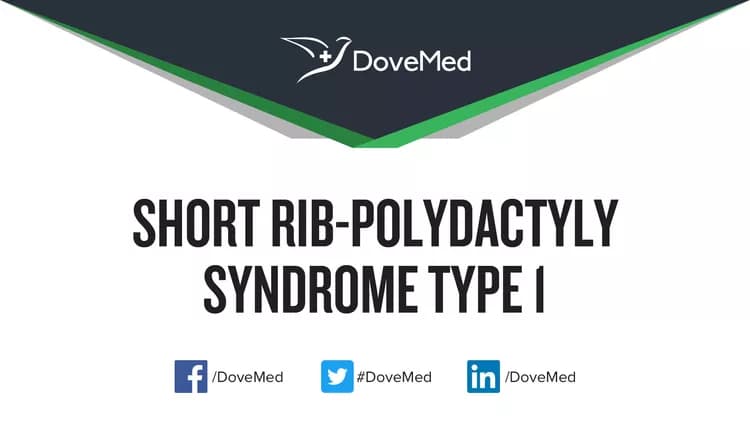What are the other Names for this Condition? (Also known as/Synonyms)
- Polydactyly with Neonatal Chondrodystrophy Type 1
- Short Rib-Polydactyly Syndrome, Saldino-Noonan type
- SRPS Type 1
What is Short Rib-Polydactyly Syndrome Type 1? (Definition/Background Information)
- Short Rib-Polydactyly Syndrome (SRPS), Saldino-Noonan type is an extremely rare type of SRPS with neonatal onset characterized by polydactyly, hydropic appearance, and small thorax with short horizontal ribs causing fatal cardiorespiratory distress
- Affected patients also have extreme micromelia (''flipper-like''extremities), pointed metaphyses, and a range of other ossification defects (vertebrae, calvaria, pelvis, hand and foot bones)
- Extraskeletal manifestations may include polycystic kidneys, transposition of the great vessels, and atresia of the gastrointestinal and genitourinary systems
(Source: Short Rib-Polydactyly Syndrome Type 1; Orphanet, National Institute of Health and Medical Research (INSERM), Paris.)
Who gets Short Rib-Polydactyly Syndrome Type 1? (Age and Sex Distribution)
- Short Rib-Polydactyly Syndrome Type 1 is a rare congenital disorder. The presentation of symptoms may occur at birth
- Both males and females may be affected
- Worldwide, individuals of all racial and ethnic groups may be affected
What are the Risk Factors for Short Rib-Polydactyly Syndrome Type 1? (Predisposing Factors)
- A positive family history may be an important risk factor, since Short Rib-Polydactyly Syndrome Type 1 can be inherited
- Children of consanguineous parents may bear a higher risk of being affected by this disorder
It is important to note that having a risk factor does not mean that one will get the condition. A risk factor increases one’s chances of getting a condition compared to an individual without the risk factors. Some risk factors are more important than others.
Also, not having a risk factor does not mean that an individual will not get the condition. It is always important to discuss the effect of risk factors with your healthcare provider.
What are the Causes of Short Rib-Polydactyly Syndrome Type 1? (Etiology)
- The genetic cause of Short Rib-Polydactyly Syndrome Type 1 is not known at the present time
- The condition is believed to be inherited in an autosomal recessive manner
Autosomal recessive inheritance: Autosomal recessive conditions are traits or disorders that occur when two copies of an abnormal gene have been inherited on a non-sex chromosome. If both parents have an autosomal recessive condition, there is a 100% likelihood of passing on the mutated genes to their children. If, however, only one mutant copy of the gene is inherited, the individual will be a carrier of the condition, but will not be present with any symptoms. Children born to two carriers, have a 25% chance of being homozygous dominant (unaffected), a 50% chance of being heterozygous (carrier), and a 25% chance of being homozygous recessive (affected).
What are the Signs and Symptoms of Short Rib-Polydactyly Syndrome Type 1?
The signs and symptoms of Short Rib-Polydactyly Syndrome Type 1 may vary among affected individuals in type and severity.
- Polydactyly
- Hydropic appearance of cells (cytoplasm looks glassy)
- Small thorax with short horizontal ribs
- Extreme micromelia (very small and improperly formed “flipper-like” extremities)
- Pointed metaphyses
- Polycystic kidneys
- Transposition of the great vessels
- Atresia of the gastrointestinal and genitourinary systems
How is Short Rib-Polydactyly Syndrome Type 1 Diagnosed?
Short Rib-Polydactyly Syndrome Type 1 is diagnosed on the basis of the following information:
- Complete physical examination
- Thorough medical history evaluation
- Assessment of signs and symptoms
- Laboratory tests
- Imaging studies
- Biopsy studies, if necessary, to check for hydropic appearance of cells
- An autopsy may be performed, in some cases
Many clinical conditions may have similar signs and symptoms. Your healthcare provider may perform additional tests to rule out other clinical conditions to arrive at a definitive diagnosis.
What are the possible Complications of Short Rib-Polydactyly Syndrome Type 1?
The complications of Short Rib-Polydactyly Syndrome Type 1 may include:
- Extreme respiratory distress
- Cardiac arrest
- Asphyxia
- Fetal demise
Complications may occur with or without treatment, and in some cases, due to treatment also.
How is Short Rib-Polydactyly Syndrome Type 1 Treated?
There is no cure for Short Rib-Polydactyly Syndrome Type 1, since it is thought to be a genetic condition. The treatment is usually given to manage the signs and symptoms and any complication that develops.
How can Short Rib-Polydactyly Syndrome Type 1 be Prevented?
Short Rib-Polydactyly Syndrome Type 1 may not be preventable, since it is a genetic disorder.
- If there is a family history of the condition, then genetic counseling will help assess risks, before planning for a child
- Active research is currently being performed to explore the possibilities for treatment and prevention of inherited and acquired genetic disorders
Regular medical screening at periodic intervals with tests and physical examinations are recommended.
What is the Prognosis of Short Rib-Polydactyly Syndrome Type 1? (Outcomes/Resolutions)
- The prognosis of Short Rib-Polydactyly Syndrome Type 1 is dependent upon the severity of the signs and symptoms and associated complications, if any
- In many cases, parents may opt to terminate pregnancy due to severe congenital abnormalities apparent from pre-natal testing. In others, the fetus may succumb to the condition in the womb, or may be stillborn
- Typically, the prognosis may be assessed on a case-by-case basis
Additional and Relevant Useful Information for Short Rib-Polydactyly Syndrome Type 1:
The following DoveMed website link is a useful resource for additional information:
Related Articles
Test Your Knowledge
Asked by users
Related Centers
Related Specialties
Related Physicians
Related Procedures
Related Resources
Join DoveHubs
and connect with fellow professionals


0 Comments
Please log in to post a comment.